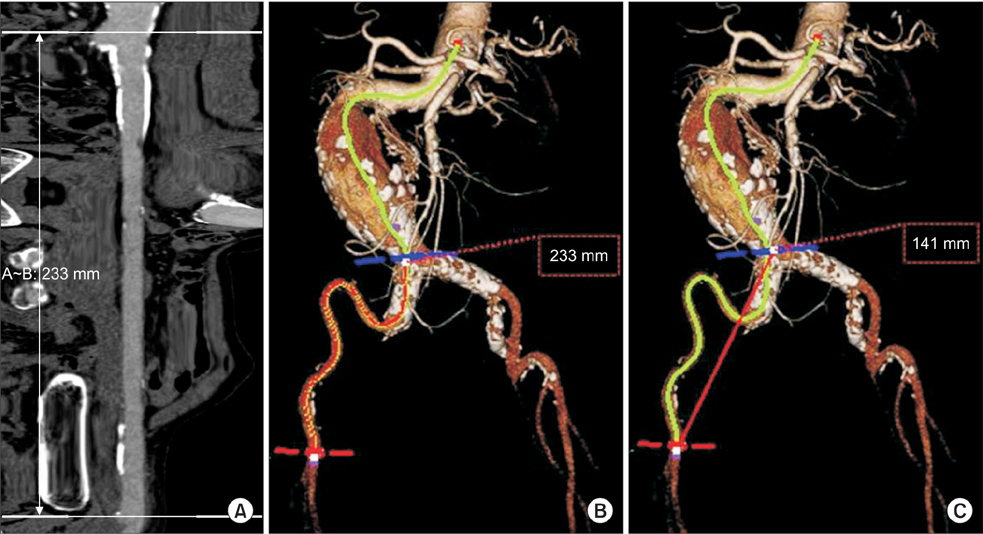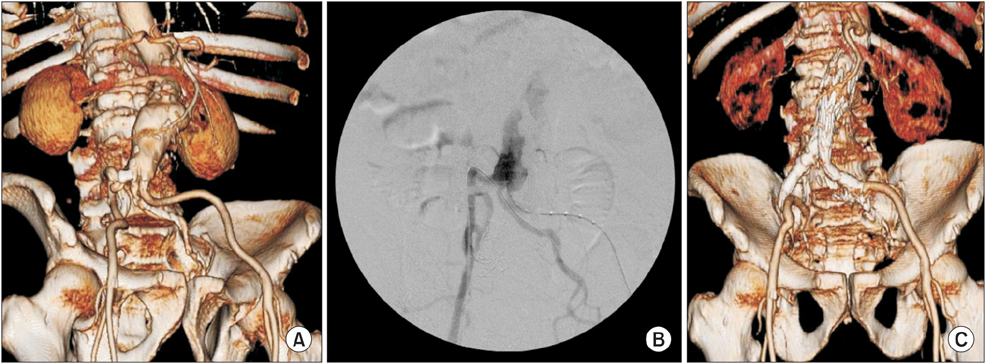Ann Surg Treat Res.
2015 Jun;88(6):334-340. 10.4174/astr.2015.88.6.334.
Iliac anatomy and the incidence of adjunctive maneuvers during endovascular abdominal aortic aneurysm repair
- Affiliations
-
- 1Division of Transplantation and Vascular Surgery, Department of Surgery, Yeungnam University Medical Center, Yeungnam University College of Medicine, Daegu, Korea. wsyun@ynu.ac.kr
- 2Division of Vascular/Endovascular Surgery, Department of Surgery, Daegu Catholic University Medical Center, Catholic University of Daegu School of Medicine, Daegu, Korea.
- KMID: 1800647
- DOI: http://doi.org/10.4174/astr.2015.88.6.334
Abstract
- PURPOSE
Challenging iliac anatomy remains an important issue during endovascular aneurysm repair (EVAR), and it is known that the length of the common iliac artery (CIA) is shorter in Asians than in Western groups. We analyzed both the iliac anatomy and the incidence of adjunctive maneuvers to overcome iliac artery-related difficulties during EVAR.
METHODS
Seventy-four EVARs were performed for abdominal aortic aneurysm between January 2010 and March 2013. Patient demographic data, iliac anatomical characteristics (presence of iliac artery aneurysm, iliac artery diameter and length, and iliac tortuosity), and adjunctive iliac artery maneuvers were reviewed retrospectively.
RESULTS
Mean CIA length was 52.8 mm (range, 6.6-98.0 mm) on the right and 56.3 mm (range, 0-94.8 mm) on the left. CIA length was > or =20 mm, except in one patient with bilateral short CIAs. Forty patients (54%) had a CIA aneurysm, and 18 had aneurysms on both sides. Iliac adjunctive procedures were performed in 38 patients (51%) as follows: 23 internal iliac artery (IIA) embolizations or ligations, seven IIA revascularizations, 16 external iliac artery (EIA) balloon angioplasties or stenting, one EIA patch angioplasty, one EIA interposition, two femoral endarterectomies with patch angioplasty, and nine femoro-femoral bypasses after EVAR with an aorto-uni-iliac device. Technical success for the adjunctive iliac procedures was achieved in all patients.
CONCLUSION
Short CIA length was uncommon. Although many patients had access-related difficulties, most were overcome by an endovascular or hybrid technique. Liberal use of iliac adjunctive procedures can facilitate EVAR.
MeSH Terms
Figure
Cited by 1 articles
-
Treatment options for isolated iliac artery aneurysms and their impact on aortic diameter after treatment
Jang Yong Kim, Dae Hwan Kim, Cheng Quan, Young Ju Suh, Hyun Young Ann, Ji Il Kim, In Sung Moon, Taeseung Lee
Ann Surg Treat Res. 2019;96(3):146-151. doi: 10.4174/astr.2019.96.3.146.
Reference
-
1. Murray D, Ghosh J, Khwaja N, Murphy MO, Baguneid MS, Walker MG. Access for endovascular aneurysm repair. J Endovasc Ther. 2006; 13:754–761.2. Henretta JP, Karch LA, Hodgson KJ, Mattos MA, Ramsey DE, McLafferty R, et al. Special iliac artery considerations during aneurysm endografting. Am J Surg. 1999; 178:212–218.3. Walker TG, Kalva SP, Yeddula K, Wicky S, Kundu S, Drescher P, et al. Clinical practice guidelines for endovascular abdominal aortic aneurysm repair: written by the Standards of Practice Committee for the Society of Interventional Radiology and endorsed by the Cardiovascular and Interventional Radiological Society of Europe and the Canadian Interventional Radiology Association. J Vasc Interv Radiol. 2010; 21:1632–1655.4. Chaikof EL, Blankensteijn JD, Harris PL, White GH, Zarins CK, Bernhard VM, et al. Reporting standards for endovascular aortic aneurysm repair. J Vasc Surg. 2002; 35:1048–1060.5. Cheng SW, Ting AC, Ho P, Poon JT. Aortic aneurysm morphology in Asians: features affecting stent-graft application and design. J Endovasc Ther. 2004; 11:605–612.6. Park KH, Lim C, Lee JH, Yoo JS. Suitability of endovascular repair with current stent grafts for abdominal aortic aneurysm in Korean patients. J Korean Med Sci. 2011; 26:1047–1051.7. Hobo R, Sybrandy JE, Harris PL, Buth J. EUROSTAR Collaborators. Endovascular repair of abdominal aortic aneurysms with concomitant common iliac artery aneurysm: outcome analysis of the EUROSTAR Experience. J Endovasc Ther. 2008; 15:12–22.8. Criado FJ, Wilson EP, Velazquez OC, Carpenter JP, Barker C, Wellons E, et al. Safety of coil embolization of the internal iliac artery in endovascular grafting of abdominal aortic aneurysms. J Vasc Surg. 2000; 32:684–688.9. Karch LA, Hodgson KJ, Mattos MA, Bohannon WT, Ramsey DE, McLafferty RB. Adverse consequences of internal iliac artery occlusion during endovascular repair of abdominal aortic aneurysms. J Vasc Surg. 2000; 32:676–683.10. Wolpert LM, Dittrich KP, Hallisey MJ, Allmendinger PP, Gallagher JJ, Heydt K, et al. Hypogastric artery embolization in endovascular abdominal aortic aneurysm repair. J Vasc Surg. 2001; 33:1193–1198.11. Yano OJ, Morrissey N, Eisen L, Faries PL, Soundararajan K, Wan S, et al. Intentional internal iliac artery occlusion to facilitate endovascular repair of aortoiliac aneurysms. J Vasc Surg. 2001; 34:204–211.12. Engelke C, Elford J, Morgan RA, Belli AM. Internal iliac artery embolization with bilateral occlusion before endovascular aortoiliac aneurysm repair-clinical outcome of simultaneous and sequential intervention. J Vasc Interv Radiol. 2002; 13:667–676.13. Bratby MJ, Munneke GM, Belli AM, Loosemore TM, Loftus I, Thompson MM, et al. How safe is bilateral internal iliac artery embolization prior to EVAR. Cardiovasc Intervent Radiol. 2008; 31:246–253.14. Rayt HS, Bown MJ, Lambert KV, Fishwick NG, McCarthy MJ, London NJ, et al. Buttock claudication and erectile dysfunction after internal iliac artery embolization in patients prior to endovascular aortic aneurysm repair. Cardiovasc Intervent Radiol. 2008; 31:728–734.15. Lee WA, Berceli SA, Huber TS, Ozaki CK, Flynn TC, Seeger JM. Morbidity with retroperitoneal procedures during endovascular abdominal aortic aneurysm repair. J Vasc Surg. 2003; 38:459–463.16. McDonnell CO, Semmens JB, Allen YB, Jansen SJ, Brooks DM, Lawrence-Brown MM. Large iliac arteries: a high-risk group for endovascular aortic aneurysm repair. J Endovasc Ther. 2007; 14:625–629.17. Torsello G, Schonefeld E, Osada N, Austermann M, Pennekamp C, Donas KP. Endovascular treatment of common iliac artery aneurysms using the bell-bottom technique: long-term results. J Endovasc Ther. 2010; 17:504–509.18. Naughton PA, Park MS, Kheirelseid EA, O'Neill SM, Rodriguez HE, Morasch MD, et al. A comparative study of the bell-bottom technique vs hypogastric exclusion for the treatment of aneurysmal extension to the iliac bifurcation. J Vasc Surg. 2012; 55:956–962.19. Karthikesalingam A, Hinchliffe RJ, Holt PJ, Boyle JR, Loftus IM, Thompson MM. Endovascular aneurysm repair with preservation of the internal iliac artery using the iliac branch graft device. Eur J Vasc Endovasc Surg. 2010; 39:285–294.20. Lobato AC. Sandwich technique for aortoiliac aneurysms extending to the internal iliac artery or isolated common/internal iliac artery aneurysms: a new endovascular approach to preserve pelvic circulation. J Endovasc Ther. 2011; 18:106–111.21. Lobato AC, Camacho-Lobato L. The sandwich technique to treat complex aortoiliac or isolated iliac aneurysms: results of midterm follow-up. J Vasc Surg. 2013; 57:2 Suppl. 26S–34S.22. Abul-Khoudoud OR, Criado FJ, Wilson EP. Endovascular AAA repair: management strategies for the iliac artery. J Invasive Cardiol. 2000; 12:221–224.23. Tillich M, Bell RE, Paik DS, Fleischmann D, Sofilos MC, Logan LJ, et al. Iliac arterial injuries after endovascular repair of abdominal aortic aneurysms: correlation with iliac curvature and diameter. Radiology. 2001; 219:129–136.24. Carroccio A, Faries PL, Morrissey NJ, Teodorescu V, Burks JA, Gravereaux EC, et al. Predicting iliac limb occlusions after bifurcated aortic stent grafting: anatomic and device-related causes. J Vasc Surg. 2002; 36:679–684.25. Fernandez JD, Craig JM, Garrett HE Jr, Burgar SR, Bush AJ. Endovascular management of iliac rupture during endovascular aneurysm repair. J Vasc Surg. 2009; 50:1293–1299.26. Criado FJ. Iliac arterial conduits for endovascular access: technical considerations. J Endovasc Ther. 2007; 14:347–351.27. Peterson BG, Matsumura JS. Internal endoconduit: an innovative technique to address unfavorable iliac artery anatomy encountered during thoracic endovascular aortic repair. J Vasc Surg. 2008; 47:441–445.28. Jean-Baptiste E, Batt M, Azzaoui R, Koussa M, Hassen-Khodja R, Haulon S. A comparison of the mid-term results following the use of bifurcated and aorto-uni-iliac devices in the treatment of abdominal aortic aneurysms. Eur J Vasc Endovasc Surg. 2009; 38:298–304.
- Full Text Links
- Actions
-
Cited
- CITED
-
- Close
- Share
- Similar articles
-
- Adjunctive Procedures for Challenging Endovascular Abdominal Aortic Repair: When Needed and How Effective?
- Novel Strategies for the Hostile Iliac Artery during Endovascular Aortic Aneurysm Repair
- Abdominal Aortic Aneurysm
- Endovascular aortic aneurysm repair using a bifurcated stent graft in a patient with femoro-femoral bypass
- Endovascular Stent-Graft Placement and Secondary Intervention for Abdominal Aortic Aneurysm in a Patient who had a Previously Inserted Iliac Stent



